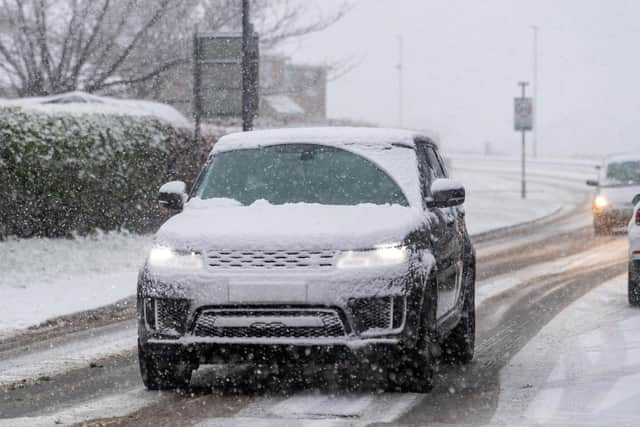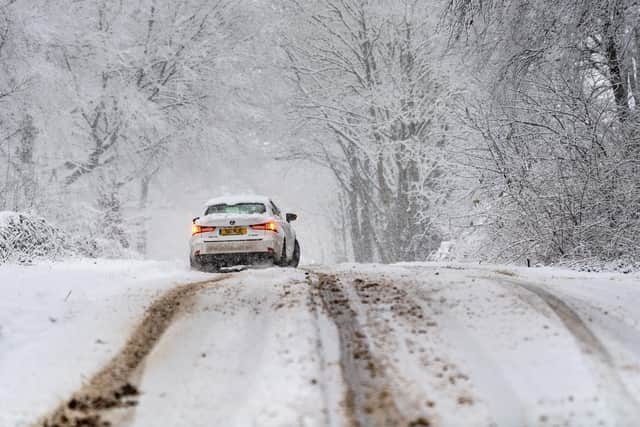Leeds snow: How to drive safely in the snow and ice in Leeds and avoid being fined £2,500 by police
and live on Freeview channel 276
But there are still people who need to get to work - nurses and doctors, for one - who will be trying to battle through the snow to provide for the rest of us.
If you are heading out in the car, there are a few things to be mindful of to avoid a fine.
Advertisement
Hide AdAdvertisement
Hide AdAs forecasters have issued further snow and ice warnings this week, taking care on the road is more important than ever.


Not de-icing your car effectively could lead to a £60 fine, points on your license or even a fine of £2,500 if your vehicle is classed as dangerous.
The highway code states what you must do before setting off in the snow:
- you MUST be able to see, so clear all snow and ice from all your windows
Advertisement
Hide AdAdvertisement
Hide Ad- you MUST ensure that lights are clean and number plates are clearly visible and legible


- make sure the mirrors are clear and the windows are demisted thoroughly
- remove all snow that might fall off into the path of other road users
-check your planned route is clear of delays and that no further snowfalls or severe weather are predicted
Advertisement
Hide AdAdvertisement
Hide AdMark Greening, Driving Expert from GoCompare, said: "If you have to drive, allow more time so you can take it slow and pause your journey if you get caught in a bad patch.
"Always keep both hands on the wheel and slow down to maintain control of the car.
"Wind can be persistent during the winter - so it can cause your car to drift or veer with no warning, make sure you have the appropriate light settings on, therefore allowing other people to see you more clearly.
"Wearing comfortable shoes will also benefit driving, as well as pulling off in second gear as this will allow you to avoid wheel spins.
Advertisement
Hide AdAdvertisement
Hide AdOther important things to remember when driving in these conditions include:
-️ De-ice your car thoroughly before you set off - you could be fined if you cannot see out of your window screen properly
️ - Leave large gaps between vehicles in front - overall stopping distances are much greater when driving in colder conditions
- If you do end up skidding - ease into it. Do not make any quick decisions if you skid, you are more likely to cause damage if you think too quickly.
Advertisement
Hide AdAdvertisement
Hide Ad- Driving slowly will also increase the distance between you and the driver in front as you may lose visibility. Always reduce your speed slowly and avoid harsh braking or sharp steering. When braking is essential, keep it smooth and gentle - being aware and anticipating the road ahead is the key. If you start to skid or lose control, release the brakes and turn smoothly into the slide (ie if the rear is skidding right, gently steer right).
- If you're struggling, try starting in second gear instead of first. If you live in an area that is prone to icy conditions and you’re unable to move your vehicle, don’t try to. Wait for appropriate help and do not cause any further danger. When preparing for your journey, make sure your mobile phone is fully charged, you have an extra set of clothes stored somewhere and that you have a full water bottle - people are surprised when they hear about how often this actually happens and are not fully equipped for longer waiting times than usual."
The increased risk of accidents and breakdowns, caused by conditions such as ice, snow and darker days, is not only a concern for personal safety: this could also result in new claims having to be made on your car insurance and therefore more expensive quotes in the future.
To help drivers across the UK be better prepared for driving in cold weather and reduce the risk of accidents, Rooster Insurance, an app-based car insurance provider for good drivers, have shared some top tips for driving safely this winter.
The firm shared these tips:
Advertisement
Hide AdAdvertisement
Hide Ad- Check your engine: Before you start driving in snowy conditions, it is important to make sure that not only are you prepared for the journey, but that your car is too. When checking your engine, it is a good idea to consider changing your oil as this can reduce the risk of engine damage. You can also mitigate the risk of damage by adding anti-freeze to the water in the engine’s cooling system – combining anti-freeze with water reduces the chances of a frozen or cracked engine.
- Remember, slow and spacious: When it comes to driving in the snow or on icy roads, there are two key phrases to remember: drive slowly and allow space on the roads. Particularly when you are driving uphill, keep as much space as possible between yourself and other cars on the road – this will help you to maintain a steady speed without having to suddenly change gears. Stopping distances for cars can be ten times slower in icy conditions too, so make sure to drive slowly and carefully to avoid losing control of your vehicle.
- Keep windscreens clear: Before you set off, make sure your windscreen is clean and clear. A common mistake that many drivers make when trying to melt ice is pouring boiling water directly on to their windscreen - this can cause your windscreen to crack so is something to be avoided. Instead, opt for useful tools such as de-icer and an ice scraper to clean your windows and, if you do need to use any water, allow time for the water to cool after boiling before pouring onto the windscreen.
- Another top tip is to ensure that your engine is topped up with shop bought screen wash, which is far less likely to freeze than soapy water. Keeping your windscreen clear in harsh conditions can be very difficult, even when you have taken precautions, so do not hesitate to pull over at available service stations, the leftmost lane on motorways or any safe stopping points on your route to allow time to demist your screen whilst driving.